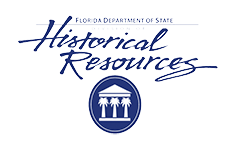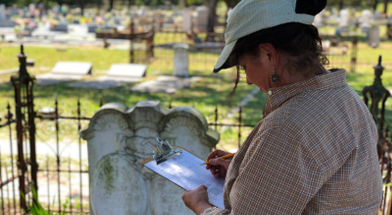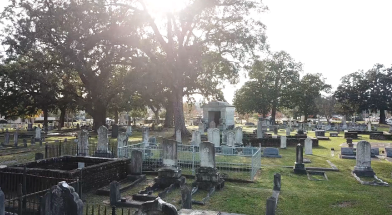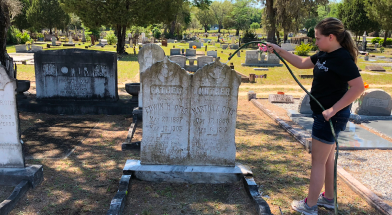Projects
Florida Historic Cemetery Inventory
A project of the Florida Division of Historical Resources, Bureau of Historic Preservation, with support from the Florida Public Archaeology Network

Why historic cemeteries?
Cemeteries are among the most under-recorded historic resources in Florida. Currently, more than 260,000 cultural and historical sites are recorded in the Florida Master Site File, but only about 2,050 are cemeteries. Conservative estimates indicate that there are 5,000 to 7,000 historic cemeteries in the state that are over 50 years of age. This means that approximately three quarters of the historic cemeteries in Florida have not been recorded. We need your help to find and record them!
The Florida Division of Historical Resources (DHR) maintains the state’s inventory of historical and cultural resources in the Florida Master Site File (FMSF). Recorded resources include buildings, structures, bridges, objects, shipwrecks, historic and prehistoric archaeological sites, historic districts, linear resources, landscapes, traditional cultural properties, and cemeteries. Sites and information are continually being added to the FMSF inventory as they are discovered or become older with time.

Why should we record historic cemeteries?
Cemeteries recorded in the FMSF are much less likely to be destroyed as a result of construction and development because their locations are known in advance. As Florida continues to grow, the search for undeveloped land increases. Historic cemeteries that once belonged to families or were privately owned fall into disrepair and are forgotten. When development begins and no one knows a historic cemetery is present, there are unintended consequences. Recording cemeteries in the FMSF can help to prevent disruption and protect historic burial sites. FMSF data can be shared with all county property appraisers so that buyers and developers know of the presence of a cemetery at the early stages of project planning.

How does the Historic Cemetery Inventory form help?
By completing our short online form, you can help ensure these often-forgotten but important historic sites are recorded. If you would like to request a physical postcard-sized form to mail in, you can request one here. When your online submission or postcard is received, DHR staff will consult the FMSF data to see if the cemetery is already recorded. If the cemetery has already been recorded, your submission will be used to update the existing file. If the cemetery is not recorded, DHR and Florida Public Archaeology Network (FPAN) staff will visit the cemetery to further document the site and determine its boundaries. It will then be recorded in the FMSF. Please note it is not necessary for the person submitting the form to visit the cemetery.
Some historic cemeteries are on private property, and permission of the property owner must always be obtained in advance of accessing the land.
Historic Cemetery Inventory Online Form
How do I fill out the Historic Cemetery Inventory form?
Cemetery Name (if known): The cemetery’s name, or what you may know it as. It could be named after a former church, local landmark, or the family that started it.
Closest Address: The nearest postal address of a home, church, or business will help us find it. You can also include a nearby crossroad, bridge, or landmark.
City/Town and County: The nearest community and the county where the cemetery is located.
GPS Coordinates (optional): Provide these if you can, using your smart phone or hand-held GPS unit. A spot near visible headstones is ideal. This is optional if you don’t know or can’t determine the GPS coordinates.
Approximate year established (if known): This date can be determined through local records, stories or memory, or the date on the earliest headstone you can find. The county clerk’s office or county property appraiser may also be able to help.
Earliest/Latest headstone dates: If headstones are visible, look to see the earliest and latest dates. If no headstones are visible, you may write “no headstones,” or if no dates are readable, you may use “cannot determine.”
Circle all that apply: Based on your observation – is the cemetery abandoned? Is it overgrown with weeds and trees? Does it appear well-maintained with grass cut, bushes trimmed, and headstones cleaned? Are headstones broken or is there evidence of other vandalism? Is the cemetery threatened by construction, erosion, falling trees, animals, or other hazards?
Describe visible damage: What do you see in terms of collapsing vaults, fallen headstones, animal burrows, storm damage, vandalism, or anything else?
Approximate size of cemetery/number of headstones: Provide an estimate of the square footage or acreage, or the number of headstones still visible. Don’t worry if it’s not perfect. Even one headstone or known grave is sufficient to record a cemetery. Sometimes older relatives remember the locations of cemeteries when all evidence above ground is gone. If no headstones are present, please fill out the form, and FPAN will work with DHR to verify the location.
Contact Information (optional):Provide your contact information, only if you want to. If the cemetery is not recorded in the FMSF, we would probably like to contact you to make sure we go to the right place, and to see if you would like to be involved. However, you are under no obligation and may remain anonymous if you wish.
If sending in a postcard form, please note that they are already addressed but do require a first class stamp!

Now that the cemetery is recorded, how can I help maintain it?
Some cemeteries are privately owned. However, descendants, families, churches, and local organizations can certainly “adopt” cemeteries, with land-owner permission, and can contribute to their detailed recording and preservation. Other cemeteries may be abandoned, and if an owner cannot be found, you can contact your county government officials for more information.
DO NOT use bleach on historic headstones and DO NOT pressure wash them!
For more information on best practices for cemetery care, FPAN also offers Cemetery Resources Protection Training (CRPT) workshops to train you in proper recording, cleaning, and preservation techniques.